| |
|
Xiamen Oil Paintings, Wholesale Direct!
|
|
100% hand painted, 100% cotton canvas, 100% money back if not satisfaction. |
|
|
|
|
ART WORKS INDEX
A
B
C
D
E
F
G
H
I
J
K
L
M
N
O
P
Q
R
S
T
U
V
W
X
Y
Z
|
|
ARTISTS INDEX
A
B
C
D
E
F
G
H
I
J
K
L
M
N
O
P
Q
R
S
T
U
V
W
X
Y
Z
|
|
|
|
 |
Henri Leys
|
|
(18 February 1815 - 26 August 1869), also known as Henri Leys, was a Belgian painter and printmaker.
Henri Leys was born and died in Antwerp. He studied with Mathieu Ignace Van Bree (1773-1839) at the Koninklijke Academie voor Schone Kunsten in Antwerp and then with his brother-in-law Ferdinand De Braekeleer (1792-1883). At the start of his career, he worked with the Belgian Romantic painter Egide Charles Gustave Wappers (1803-1874). Both artists were interested in nationalistic subjects painted in styles that owe much to the example of 16th- and 17th-century Flemish painting. In 1835 Leys went to Paris where he visited the studio of Eugene Delacroix and met Paul Delaroche. During the 1840s, Leys began painting scenes set in 16th-century Antwerp, combining details studied from life with a deliberately archaizing style reminiscent of 16th-century German painters like Albrecht Derer and Quinten Matsys. Some of the pictures have specific historical subjects, but others are genre scenes. With these pictures, he earned a following among many younger artists in Belgium as well as a considerable reputation in France, where he won a gold medal at the International Exhibition in Paris in 1855 for his historical painting The Mass of Berthal de Haze (Royal Museum of Fine Arts, Brussels). In 1862 Leys was created a baron by King Leopold I. At the time of his death, he was engaged in decorating the interior of the Antwerp Town Hall with monumental frescoes depicting the city's history (1863-9). There are easel replicas of these in Brussels. Among the artists who studied with him are James Tissot and Sir Lawrence Alma-Tadema. His best-known pupil is his nephew Henri De Braekeleer (1840-1888).
|
|
|
|
 |
Henri Lehmann
|
|
German Neoclassical Painter, 1814-1882,was a French historical and portrait painter, born in Kiel, Schleswig. He was a pupil of his father, Leo Lehmann, and of Ingres in Paris, where he opened a studio in 1847, after having become naturalized. His brother Rudolf Lehmann was a well-known portrait artist.
|
|
 |
Henri Lebasque Prints
|
|
French Painter, 1865-1937
was born in 1865 at Champign?? (Maine-et-Loire). He started his education at the Ecole des Beaux-Arts d??Angers, and moved to Paris in 1886. Here, Lebasque started studying under L??on Bonnat, and assisted Humbert with the decorative murals at the Panth??on. Around this time, Lebasque met Camille Pissarro and Auguste Renoir, who later would have a large impact on his work.
Lebasque's vision was coloured by his contact with younger painters, especially Edouard Vuillard and Pierre Bonnard, founders of the The Nabis' Group and the Intimists who first favoured the calm and quietude of domestic subject matter. From his first acquaintance with Georges Seurat and Paul Signac, Lebasque learnt the significance of a colour theory which stressed the use of complementary colours in shading.
Lebasque was a founding member of the Salon d'Automne in 1903 with his friend Henri Matisse. Two years later a group of artists exhibited there including Georges Rouault, Andr?? Derain, Edouard Vuillard and Henri Matisse while keeping solid links with other artists such as Gustave Rouault, Raoul Dufy, Louis Valtat and especially Henri Manguin, who made him discover the south of France.
His time in South of France would lead to a radical transformation in Lebasque??s paintings, changing his colour palette forever. Other travels included the Vend??e, Normandie and Brittany, although Lebasque would always prefer the small idyllic villages of the South of France.
Lebasque had some commercial success during his lifetime. He worked on the decorations at the theatre of the Champs-Elys??es and of the Transatlantique sealiner.
Lebasque died at Cannet, Alpes Maritimes in 1937.
His work is represented in French museums, notably Angers, Geneva (Petit Palais), Lille (Mus??e des Beaux-Arts), Nantes and Paris (Mus??e d??Orsay) as well as many more around the world. Famed as a painter of 'joy and light', Lebasque is admired for the intimacy of his subject matter and his unique delight in colour and form.
|
|
 |
Henri Le Sidaner
|
|
(August 7, 1862 - July 1939) was an Intimist painter born to a French family in Port Louis, Mauritius. In 1870 he and his family settled in Dunkirk. Le Sidaner received most of his tutelage from the École des Beaux-Arts under the instruction of Alexandre Cabanel but later broke away due to artistic differences.
He travelled extensively throughout France and also visited many cities around the globe such as London, New York, Venice and Paris as well as some small villages throughout Europe. Le Sidaner exhibited at the Salon, the Galeries Georges Petit in Paris and the Goupil Gallery in London. He lived in Gerberoy, France.
Le Sidaner's work was mentioned in Marcel Proust's novel In Search of Lost Time. In Sodom and Gomorrah, the narrator mentions that an eminent barrister from Paris had devoted his income to collecting the paintings of the "highly distinguished" but "not great" Le Sidaner.
|
|
|
|
 |
Henri Harpignies
|
|
(June 28, 1819 - August 28, 1916) was a French landscape painter of the Barbizon school.
He was born at Valenciennes. His parents intended for him to pursue a business career, but his determination to become an artist was so strong that it conquered all obstacles, and he was allowed at the age of twenty-seven to enter Jean Achard's atelier in Paris. From this painter he acquired a groundwork of sound constructive draughtsmanship, which is so marked a feature of his landscape painting. After two years under this exacting teacher he went to Italy, whence he returned in 1850.
During the next few years he devoted himself to the painting of children in landscape setting, and fell in with Corot and the other Barbizon masters, whose principles and methods are to a certain extent reflected in his own personal art. To Corot he was united by a bond of warm friendship, and the two artists went together to Italy in 1860.
On his return, he scored his first great success at the Salon, in 1861, with his Lisiere de bois sur les bords de l'Allier. After that year he was a regular exhibitor at the old Salon; in 1886 he received his first medal for Le Soir dans la campagne de Rome, which was acquired for the Luxembourg Gallery.
Many of his best works were painted at Herisson in the central France region of Bourbonnais, as well as in the Nivernais and Auvergne regions.
|
|
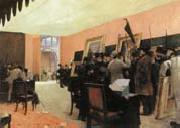 |
Henri Gervex
|
|
French Academic Painter, 1852-1929.French painter. His artistic education began with the Prix de Rome winner Pierre Brisset (1810-90). He then studied under Alexandre Cabanel at the Ecole des Beaux-Arts in Paris, where his fellow pupils included Henri Regnault, Bastien-Lepage, Forain, Humbert (1842-1934) and Cormon; and also informally with Fromentin. Gervexs first Salon picture was a Sleeping Bather (untraced) in 1873: the nude, both in modern and mythological settings, was to remain one of his central artistic preoccupations. In 1876 he painted Autopsy in the H?tel-Dieu (ex-Limoges; untraced), the sort of medical group portrait he repeated in 1887 with his Dr Pean Demonstrating at the Saint-Louis Hospital his Discovery of the Hemostatic Clamp (Paris, Mus. Assist. Pub.), which celebrated the progress of medical science with a sober, quasi-photographic realism. Gervexs most controversial picture was Rolla (1878; Bordeaux, Mus. B.-A.), refused by the Salon of 1878 on grounds of indecency, partly because of the cast-off corset Degas had insisted he include. The painting shows the central character in a de Musset poem, Jacques Rolla, who, having dissipated his family inheritance, casts a final glance at the lovely sleeping form of the prostitute Marion before hurling himself out of the window. As his friend, Manet, had done the year before with his rejected Nana (1877; Hamburg, Ksthalle), Gervex exhibited his work in a commercial gallery, with great success.
|
|
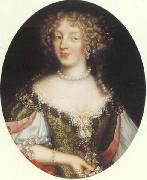 |
Henri Gascar
|
|
Henri Gascar, Portrait of Barbara Palmer, 1st Duchess of Cleveland
James II of England, then Duke of York (1660s)Henri Gascar (1635 -1 Jan 1701) was a French-born portrait painter who achieved artistic success in England during the reign of Charles II. He painted many leading ladies at court, including several of the King's mistresses.
Gascar was born in Paris, the son of Pierre Gascar, a minor painter and sculptor. Gascar came to England about 1674, probably at the behest of Louise de Keroualle, Duchess of Portsmouth, Charles II's favourite mistress. Gascar (or Gascard, as he seems to have spelt his name at first) was already known as a skillful portrait-painter; among the portraits already painted by him was that of Nicolas de Lafond, author of the "Gazette of Holland", painted in 1667, and engraved by Peter Lombart.
The patronage of the Duchess of Portsmouth insured Gascar a rapid success in England. His flamboyant style, contrasting with the stolid English approach, seemed to suit the frivolity of the time and he painted many of the ladies of Charles II's court. His lack of attention to detail in the likeness he made up for by the sumptuous draperies and tawdry adornments around the subject. For a short time he became fashionable, and is said to have amassed a fortune of over £10,000.
Among the portraits painted by him during his time in England were Charles II (engraved by Peter Vanderbank); Louise, Duchess of Portsmouth (twice - once engraved by Étienne Baudet); Barbara, Duchess of Cleveland (nee Villiers), and her daughter, Barbara Fitzroy; Charles Lennox, 1st Duke of Richmond; Frances Stewart, Duchess of Richmond; George FitzRoy, 1st Duke of Northumberland; Nell Gwyn; Sophia Bulkeley (engraved by Robert Dunkarton); Edmund Verney; and Philip Herbert, 7th Earl of Pembroke. It is stated that the last-named portrait was done surreptitiously for Louise, Duchess of Portsmouth. A portrait by Gascar of James II as Duke of York was in that king's collection.
|
|
 |
Henri Felix Emmanuel Philippoteaux
|
|
(1815-1884) was a French artist. He was born in Paris, France, studied art at the studio of Leon Cogniet,and first exhibited his work at the Paris Salon of 1833.
One of his most well-known works was a depiction of the Siege of Paris during the Franco-Prussian War, painted in the form of a cyclorama, a type of large panoramic painting on the inside of a cylindrical platform designed to provide a viewer standing in the middle of the cylinder with a view of the painting. Viewers surrounded by the panoramic image are meant to feel as if they are standing in the midst of a historic event or famous place.
Philippoteaux also produced a large number of works chronicling the rise and successes of Napoleon Bonaparte, including a portrait of Napoleon in his regimental uniform and a group of paintings of French victories in the Napoleonic Wars. Philippoteaux was awarded the Legion d'honneur in 1846.
Philippoteaux's son Paul Philippoteaux was also an artist; both were famous for their production of cycloramas. Father and son collaborated on The Defence of the Fort d'Issy in 1871.
|
|
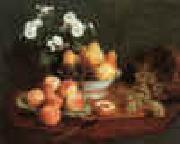 |
Henri Fantin-Latour
|
|
French 1836-1904
Henri Fantin Latour Locations
Bure) French painter and printmaker. He was trained by his father, a portrait painter, and at the Ecole des Beaux-Arts. Though he associated with progressive artists (Gustave Courbet, Eugene Delacroix, Edouard Manet), he was a traditionalist best known for his portraits and still lifes with flowers. His portrait groups, reminiscent of 17th-century Dutch guild portraits, depict literary and artistic persons of the time; his flower paintings were especially popular in England, thanks to James McNeill Whistler and John Everett Millais, who found patrons to support him. His later years were devoted to lithography.
|
|
 |
Henri Evenepoel
|
|
Belgian, 1872-1899
was a Belgian artist whose most important works are associated with Fauvism. He first studied art in Brussels at the Acad??mie des Beaux-Arts between 1889 and 1890, and entered Paris's Ecole des Beaux-Arts in 1892. Evenepoel entered the atelier of Gustave Moreau in 1893, which put him in contact with Henri Matisse and Georges Rouault. The artist debuted a portrait of his cousin (Louise in Mourning) at the 1894 Salon des Artistes Français. He showed four portraits at the Salon du Champ-de-Mars in 1895 and continued to exhibit there until his death. His first solo exhibition came at the Brussels Cercle Artistique (December 1897 C January 1898). Family and friends were the artist's preferred subjects; his full-length portraits, often against a neutral background, show the influence of Edouard Manet and James Abbott McNeill Whistler. His Parisian scenes were influenced by Henri de Toulouse-Lautrec and Jean-Louis Forain.
|
|
 |
Henri Edmond Cross
|
|
1856-1910
French
Henri Edmond Cross Locations
French painter and printmaker. The only surviving child of Alcide Delacroix, a French adventurer and failed businessman, and the British-born Fanny Woollett, he was encouraged as a youth to develop his artistic talent by his father cousin, Dr Auguste Soins. He enrolled in 1878 at the Ecoles Academiques de Dessin et d Architecture in Lille, where he remained for three years under the guidance of Alphonse Colas (1818-87). He then moved to Paris and studied with Emile Dupont-Zipcy (1822-65), also from Douai, whom he listed as his teacher when exhibiting at Salons of the early 1880s. His few extant works from this period are Realist portraits and still-lifes, painted with a heavy touch and sombre palette (example in Douai, Mus. Mun.).
|
|
|
|
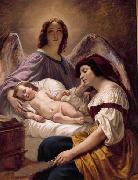 |
Henri Decaisne
|
|
a Belgian historical and portrait painter, was born at Brussels in 1799. As early as 1814 he began to study painting under François, and in 1818 upon the advice of David he went to Paris and entered the studio of Girodet, whence he removed to that of Gros. Several pictures by him are at Versailles; among them are the 'Entry of Charles VII into Rouen' (1838), and the 'Institution of the Order of St. John of Jerusalem' (1842). In 1839 he completed his colossal work, ' Les Belges Illustres.' He died in Paris in 1852. Among his best works are:
|
|
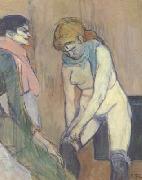 |
Henri de toulouse-lautrec
|
|
1864-1901
French painter and printmaker. He is best known for his portrayals of late 19th-century Parisian life, particularly working-class, cabaret, circus, nightclub and brothel scenes. He was admired then as he is today for his unsentimental evocations of personalities and social mores. While he belonged to no theoretical school, he is sometimes classified as Post-Impressionist. His greatest contemporary impact was his series of 30 posters (1891-1901),
|
|
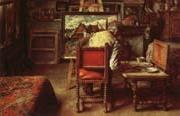 |
Henri De Braekeleer
|
|
Belgian Painter, 1840-1888
Belgian painter, was born at Antwerp. He was trained by his father, a genre painter, and his uncle, Baron Henri Leys, and devoted himself to scenes of everyday Antwerp life. The first pictures he exhibited, The Laundry (Van Cutsem collection, Brussels), and The Coppersmith's Workshop (Vleeshouwer collection, Antwerp), were shown. at the Antwerp exhibition in 1861. He received the gold medal at Brussels in 1872 for The Geographer and The Lesson (both in the Brussels gallery); the gold medal at Vienna in 1873 for The Painter's Studio and Grandmother's Birthday ; and the medal of honor at the Exposition Universelle at Amsterdam for The Pilot House. Among his more notable works are A Shoemaker (1862), A Tailor's Workroom (1863), A Gardener (1864, Antwerp gallery), Interior of a Church (1866), Interior, Flanders (1867), Woman Spinning (1869), Man Reading (1871), Theruedu Serment, Antwerp (1875), A Copperplate Printer, The Sailor's Return, The Man at the Window (Couteaux collection, Brussels), The Horn-blower (Couteaux collection), Man Retouching a Picture (Couteaux collection), The Potters (Marlier collection, Brussels), Staircase in the Hydraulic House at Antwerp (Marlier collection), and The Brewer's House at Antwerp (Marlier collection). The last, better known as A Man Sitting, is generally regarded as his masterpiece. As a lithographer and etcher, his work resembles that of Henri Leys.
|
|
|
|
 |
Henri Toulouse-Lautrec
|
|
French Post-Impressionist Painter and Printmaker, 1864-1901
Henri de Toulouse-Lautrec, a direct descendant of the counts of Toulouse, was born on Nov. 24, 1864, at Albi. His eccentric father lived in provincial luxury, hunting with falcons and collecting exotic weapons. Henri began to draw at an early age. He suffered a fall in 1878 and broke one femur; in 1879 he fell again and broke the other one. His legs did not heal properly; his torso developed normally, but his legs were permanently deformed.
Encouraged by his first teachers, the animal painters Rene Princeteau and John Lewis Brown, Toulouse-Lautrec decided in 1882 to devote himself to painting, and that year he left for Paris. Enrolling at the Ecole des Beaux-Arts, he entered the studio of Fernand Cormon. In 1884 Toulouse-Lautrec settled in Montmartre, where he stayed from then on, except for short visits to Spain, where he admired the works of El Greco and Diego Velazquez; Belgium; and England, where he visited Oscar Wilde and James McNeill Whistler. At one point Toulouse-Lautrec lived near Edgar Degas, whom he valued above all other contemporary artists and by whom he was influenced. From 1887 his studio was on the Rue Caulaincourt next to the Goupil printshop, where he could see examples of the Japanese prints of which he was so fond.
Toulouse-Lautrec habitually stayed out most of the night, frequenting the many entertainment spots about Montmartre, especially the Moulin Rouge cabaret, and he drank a great deal. His loose living caught up with him: he suffered a breakdown in 1899, and his mother had him committed to an asylum at Neuilly. He recovered and set to work again. He died on Sept. 9, 1901, at the family estate at Malrome.
|
|
 |
Hennessy, William John
|
|
English, 19th Century.was an Irish artist. William John Hennessy was born in Thomastown, County Kilkenny in 1839. His father, John Hennessy, was forced to leave Ireland in 1848 as a result of his involvement in the Young Ireland movement. He landed in Canada and settled in New York. William, his mother Catherine, and brother joined their father there in 1849. He gained admittance to the National Academy of Design in 1854 and exhibitioned his first works there. Hennessy developed a skill in wood engraving and was hired to illustrate the works of renowned poets, including that of Tennyson, Longfellow and Whittier. As an American he became the co-founder of the Artists?? Fund Society, and an honorary member of the American Society of Painters in Watercolours. In 1870 he moved to London where he became a member of the Royal Institute of Oil Painters in 1902.
|
|
 |
Hendrik Willem Mesdag
|
|
Hendrik Willem Mesdag was born on February 23, 1831 in Groningen. His father, a merchant and banker, was an amateur painter who saw to it that his two sons were also educated in the art of painting. He was a Dutch marine painter. He was born in Groningen, the son of the banker Klaas Mesdag and his wife Johanna Wilhelmina van Giffen. Mesdag was encouraged by his father, an amateur painter, to study art. He married Sina van Houten in 1856, and when they inherited a fortune from her father, Mesdag retired from banking to pursue a career as a painter. He studied in Brussels with Willem Roelofs and in 1868 moved to The Hague to paint the sea. In 1870 he exhibited at the Paris Salon and won the gold medal for The Breakers of the North Sea. Preparations for departureIn 1880 he received a commission from a Belgian company to paint a panorama giving a view over the village of Scheveningen on the North Sea coast near The Hague .
|
|
|
|
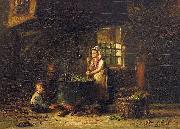 |
Hendrik Valkenburg
|
|
painted An old kitchen with a mother and two children at the cauldron in 1872
|
|
|
|
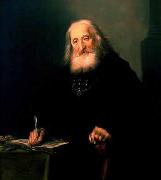 |
Hendrik Gerritsz. Pot
|
|
(c. 1580 - 15 October 1657 (buried)) was a Dutch painter. He lived and painted in Haarlem, where he was an officer of the militia, or schutterij. Dutch artist Frans Hals painted Pot in militia sash in Hals' The Banquet of the Officers of the St George Militia Company (c. 1639). Pot is the man reading a book on the far right.
Pot was born in Amsterdam and spent his early years in Amsterdam and Haarlem. In 1632 he traveled to London, where he painted the Royal Family. He lived from 1633 to 1648 in Haarlem, after which he moved to Amsterdam, where he died in 1657.. He served as Dean of the Haarlem Guild of St. Luke in 1626, 1630 and 1635. He served as the Guild's headman or Hoofdman in 1634 and 1648. He died in Amsterdam.
|
|
|
|
 |
hendrik averkamp
|
|
Hendrick Avercamp (bapt. January 27, 1585, Amsterdam - buried May 15, 1634, Kampen (Overijssel)) was a Dutch painter.
Avercamp studied in Amsterdam with the Danish-born portrait painter Pieter Isaacks (1569-1625), and perhaps also with David Vinckbooms. In 1608 he moved from Amsterdam to Kampen in the province of Overijssel. Avercamp was mute and was known as "de Stomme van Kampen" (the mute of Kampen).
As one of the first landscape painters of the 17th-century Dutch school, he specialized in painting the Netherlands in winter. Avercamp's paintings are colorful and lively, with carefully crafted images of the people in the landscape. Many of Avercamp's paintings feature people ice skating on frozen lakes.
Avercamp's work enjoyed great popularity and he sold his drawings, many of which were tinted with water-color, as finished pictures to be pasted into the albums of collectors. The Royal Collection has an outstanding collection of his works.
Avercamp died in Kampen and was interred there in the Sint Nicolaaskerk.
|
|
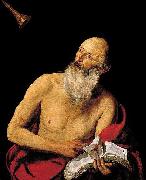 |
Hendrick van Somer
|
|
Hendrick van Someren, or Somer (1615, Amsterdam - 1685, Amsterdam), was a Dutch Golden Age painter.
According to Houbraken he was the son of the "van Zomeren" who took in the young Adriaen Brouwer after he fled Frans Hals' workshop to try his luck in Amsterdam. Houbraken claimed Henrik van Someren was a good painter of historical allegories, landscapes, and flower still lifes.
According to the RKD no works survive in the styles Houbraken mentioned, only "hermits" in the style of Ribera. He was the son of the painter Barend van Someren and the grandson of Aert Mijtens. He was the pupil of Jusepe de Ribera and at least one of his works had a forged signature of Ribera.He is possibly the same painter sometimes referred to as Enrico Fiammingo.
|
|
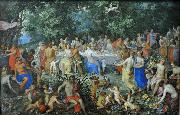 |
Hendrick van Balen the Elder
|
|
painted The Wedding of Thetis and Perseus with Apollo and the Concert of the Muses, or The Feast of the Gods in ca. 1618
|
|
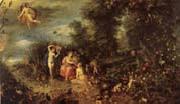 |
Hendrick van balen
|
|
Dutch Baroque Era Painter, ca.1575-1632
was a Flemish painter, who was born and died in Antwerp. Van Balen studied art while traveling in Italy. He was the teacher of Anthony Van Dyck and Frans Snyders and was also a contemporary of many of the other famous Flemish artists
|
|
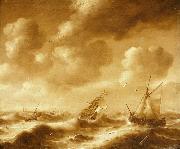 |
Hendrick van Anthonissen
|
|
(29 May 1605, Amsterdam - 12 November 1656, Amsterdam) was a Dutch marine painter.
Van Anthonissen was the son of Aert Anthonisz (a.k.a. Aart van Antum) and painted in the style of his brother-in-law and teacher Jan Porcellis and of Jan van Goyen. He is the author of sea paintings in the Hermitage, St. Petersburg and the Prague Gallery, which through their signatures have been ascribed to a mythical Hendrik van Antem. In the 1630's he lived in The Hague, Leiden, and Leiderdorp, but from 1642 he was back in Amsterdam. He is known for beach scenes and seascapes in the manner of Jan Porcellis, sometimes in grisaille. He was the father of the marine painter Arnoldus van Anthonissen.
|
|
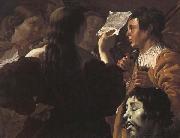 |
Hendrick the Brugghen
|
|
1588-1629
Dutch painter and draughtsman. He was, with Gerrit van Honthorst and Dirck van Baburen, one of the leading painters in the group of artists active in Utrecht in the 1620s who came to be known as the UTRECHT CARAVAGGISTI, since they adapted Caravaggio's subject-matter and style to suit the Dutch taste for religious and secular paintings. Ter Brugghen was an important innovator for later Dutch 17th-century genre painting; his recognition as an unorthodox,
|
|
 |
Hendrick Terbrugghen
|
|
1588-1629
Dutch Hendrick Terbrugghen Galleries
Dutch painter and draughtsman. He was, with Gerrit van Honthorst and Dirck van Baburen, one of the leading painters in the group of artists active in Utrecht in the 1620s who came to be known as the UTRECHT CARAVAGGISTI, since they adapted Caravaggio subject-matter and style to suit the Dutch taste for religious and secular paintings. Ter Brugghen was an important innovator for later Dutch 17th-century genre painting; his recognition as an unorthodox, but significant influence on the work of Johannes Vermeer and others is a relatively recent, 20th-century phenomenon.
|
|
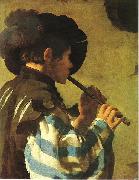 |
Hendrick ter Brugghen
|
|
(1588 - Nov 1, 1629) was a Dutch painter, and a leading member of the Dutch followers of Caravaggio ?? the so-called Dutch Caravaggisti.
Little is known of the early life of ter Brugghen; he could have been born in The Hague, but his family seems to have moved to the strongly Catholic Utrecht in the early 1590s. Here he started painting at the age of thirteen, studying with Abraham Bloemaert. From Bloemaert, a Mannerist history painter, he learned the basics of the art. Around 1604, however, ter Brugghen travelled to Italy to expand his skills, a rather unusual move for Dutch painters at the time. He was in Rome in 1604, and could therefore have been in direct contact with Caravaggio.
|
|
|
|
|
|
|
|
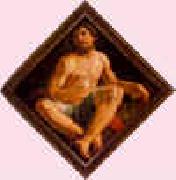 |
Hendrick Goltzius
|
|
1558-1617 Dutch
Hendrik Goltzius (1558 - January 1, 1617), Dutch printmaker, draftsman, and painter, was born at Millebrecht, in the duchy of Julich. He was the leading Dutch engraver of the early Baroque period, noted for his sophisticated technique.
After studying painting on glass for some years under his father, he was taught the use of the burin by Dirk Volkertszoon Coornhert, a Dutch engraver of mediocre attainment, whom he soon surpassed, but who retained his services for his own advantage. He was also employed by Philip Galle to engrave a set of prints of the history of Lucretia.
At the age of 21 he married a widow somewhat advanced in years, whose money enabled him to establish at Haarlem an independent business; but his unpleasant relations with her so affected his health that he found it advisable in 1590 to make a tour through Germany to Italy, where he acquired an intense admiration for the works of Michelangelo, which led him to emulate that master in the grotesqueness and extravagance of his designs. He returned to Haarlem considerably improved in health, and laboured there at his art till his death.
Goltzius' painting Lot and his daughters (Rijksmuseum Amsterdam) shows Lot being seduced by his two daughters. Sodom and Gomorrah are shown burning in the background, with Lot's wife who had turned into a pillar of salt, in front.Goltzius ought not to be judged chiefly by the works he valued most, his eccentric imitations of Michelangelo. His portraits, though mostly miniatures, are masterpieces of their kind, both on account of their exquisite finish, and as fine studies of individual character. Of his larger heads, the life-size portrait of himself is probably the most striking example. His masterpieces, so called from their being attempts to imitate the style of the old masters, have perhaps been overpraised.
Goltzius brought to an unprecedented level the use of the "swelling line", where the burin is manipulated to make lines thicker or thinner to create a tonal effect from a distance. He also was a pioneer of "dot and lozenge" technique, where dots are placed in the middle of lozenge shaped spaces created by cross-hatching to further refine tonal shading.
A self portraitHollstein credits 388 prints to him, with a further 574 by other printmakers after his designs.
In his command of the burin Goltzius is said to rival that of Durer's; but his technical skill is not equally aided by higher artistic qualities. Even, however, his eccentricities and extravagances are greatly counterbalanced by the beauty and freedom of his execution. He made engravings of Bartholomeus Spranger's paintings, thus increasing the fame of the latter - and his own. Goltzius began painting at the age of forty-two; some of his paintings can be found in the imperial collection at Vienna. He also executed a few chiaroscuro woodcuts. He was the stepfather of engraver Jacob Matham.
|
|
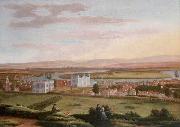 |
Hendrick Danckerts
|
|
(c.1625 - 1680) was a Dutch Golden Age landscape painter and engraver.
Danckerts was born in The Hague, where he learned his trade and remained until 1653.He visited England for the first time in 1650.In 1653 he went to Italy, where he stayed for five years. He then moved to England where he entered the service of Charles II and the Duke of York. He painted Italianate landscapes, especially views of harbors and royal residences. He also produced portraits and devotional pictures and made engravings after the Italian old masters in the Royal Collection. He left England in 1679due to the public hostility towards Roman Catholics after the Popish Plot controversy. He died soon after in Amsterdam.
|
|
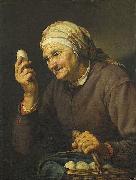 |
Hendrick Bloemaert
|
|
(1601 -- 1672), was a Dutch Golden Age painter.
Hendrick was the oldest son of Abraham Bloemaert. His brothers Cornelis and Adriaen were also painters. In 1626 he was registered in Rome, but by 1631 he was back in Utrecht, where he registered in the Utrecht Guild of St. Luke and married Margaretha van der Eem, the daughter of a lawyer.
|
|
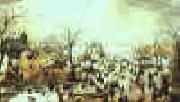 |
Hendrick Avercamp
|
|
1585-1634
Dutch
Hendrick Avercamp Galleries
Hendrick Avercamp (bapt. January 27, 1585, Amsterdam - buried May 15, 1634, Kampen (Overijssel)) was a Dutch painter.
Avercamp studied in Amsterdam with the Danish-born portrait painter Pieter Isaacks (1569-1625), and perhaps also with David Vinckbooms. In 1608 he moved from Amsterdam to Kampen in the province of Overijssel. Avercamp was deaf and was known as "de Stomme van Kampen" (the mute of Kampen).
As one of the first landscape painters of the 17th-century Dutch school, he specialized in painting the Netherlands in winter. Avercamp's paintings are colorful and lively, with carefully crafted images of the people in the landscape.
Avercamp's work enjoyed great popularity and he sold his drawings, many of which were tinted with water-color, as finished pictures to be pasted into the albums of collectors. Queen Elizabeth II has an outstanding collection of his works at Windsor Castle, England.
|
|
|
|
 |
HEMESSEN, Jan Sanders van
|
|
Netherlandish Mannerist Painter, ca.1500-1566
was a Flemish Northern Renaissance painter. He was born in Hemiksem, then called Hemessen or Heymissen. Following studies in Italy, in 1524 he settled in Antwerp. A mannerist, his images focused on human failings such as greed and vanity. Like his daughter, Catarina van Hemessen, he also painted portraits. Jan Sanders van Hemessen was a Flemish Northern Renaissance painter. Jan Sanders van Hemessen was from Netherlands. The type of movement he did was mannerism Jan Sanders was born in Hemessen but settled in Antwerp in 1524 after studying in Italy. Hemessen specialized in scenes of human character flaws such as vanity and greed. His pictures are also normally religious and his style helped found the Flemish traditions of genre painting. Hemessen was also a portrait painter, which influenced his daughter to become a Flemish Northern Renaissance painter as well. The Surgeon was painted by Jan Sanders Van Hemessen, in 1555. The oil painting is in a museum called Museo Del Prado, which is in Madrid, Spain. I think the scene painted by Jan Sanders van Hemessen shows a stone cutter at a fair. The surgeon, who is clearly happy that his operations have been successful, painstakingly moves his knife towards the stone, which is already visible. Behind him hang stones which have been successfully cut out of the head of other patients as a sign of his skill.
|
|
 |
HELST, Bartholomeus van der
|
|
Dutch Baroque Era Painter, 1613-1670
Dutch painter. He was the son of a Haarlem inn-keeper and presumably undertook part or all of his training in Amsterdam. His earliest works suggest that the painter Nicolaes Eliasz. Pickenoy was his master. Although van der Helst had probably already established himself as an independent master by the time he married Anna du Pire in Amsterdam in 1636, his earliest known work, a portrait of The Regents of the Walloon Orphanage, Amsterdam (Amsterdam, Maison Descartes), dates from 1637. Stylistically it is close to the work of Pickenoy. His portrait of a Protestant Minister of 1638 (Rotterdam, Boymans-van Beuningen) reveals the influence of Rembrandt. The young artist must have risen rapidly to fame in Amsterdam, for as early as 1639 he received the prestigious commission for a large painting for the Kloveniersdoelen (Arquebusiers' or Musketeers' Hall): The Civic Guard Company of Capt. Roelof Bicker and Lt Jan Michielsz. Blaeuw (Amsterdam, Rijksmus.), which formed part of the same series as Rembrandt's 'Night Watch' (Amsterdam, Rijksmus.). Van der Helst may not have completed this commission until 1642 or 1643. The ingenious arrangement of the figures in a broad composition shows the artist's special talent for composing large groups. Pickenoy's influence is less noticeable here than in the portrait of 1637; the self-assured poses of the individual figures were to become a characteristic feature of van der Helst's work. The successful execution of this portrait established van der Helst's reputation: from 1642, when he began to receive an increasing number of commissions for individual portraits, until 1670 he was the leading portrait painter of the ruling class in Amsterdam. From 1642 his technique in portrait painting gradually became more fluent and the rendering of costume materials more detailed. Some typical portraits of his earlier period are those of Andries Bicker (Amsterdam, Rijksmus.), his wife Catharina Gansneb Tengnagel (Dresden, Gem?ldegal. Alte Meister) and their son Gerard Bicker (Amsterdam, Rijksmus.), all of 1642, and the Portrait of a Young Girl (1645; London, N.G.). In 1648 van der Helst painted a second civic guard portrait, The Celebration of the Peace of M?nster at the Crossbowmen's Headquarters, Amsterdam (Amsterdam, Rijksmus.), a superbly composed and well painted portrait that, until the late 19th century, was considered one of the masterpieces of the Golden Age but later lost popularity because of its smooth and modish execution. It can nevertheless still be regarded as one of the most important group portraits of the 17th century.
|
|
|
|
|
|
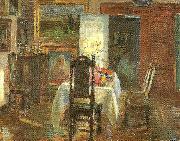 |
helga ancher
|
|
född 19 augusti 1883 i Skagen, död 18 mars 1964 i Skagen, var en dansk konstnär (målare).
Helga Ancher var dotter till konstnärerna Anna och Michael Ancher och förekommer som barn ofta som motiv i föräldrarnas målningar. Helga kom sedermera själv att utbilda sig till målare och studerade bland annat på Konstakademien i Köpenhamn samt i Tyskland, Frankrike och Italien. Även om hon aldrig blev blev lika känd för sin konst som sina föräldrar har en del av hennes tavlor kommit att betinga höga värden på auktioner.
Föräldrarnas hem i Skagen lät Helga Ancher efter moderns död 1935 bevara i det skick det hade då och skänkte sedermera detta till en stiftelse, vilken 1967 kunde öppna konstnärsbostaden som museum.
|
|
 |
Helene Schjerfbeck
|
|
Finnish Painter, 1862-1946
.Finnish painter. In 1873 she began to study at the Finnish Art Society drawing school in Helsinki. On the death of her father in 1876, she was forced to seek help to finance her studies. In 1877 she went to the private academy of Adolf von Becker (1831-1909) in Helsinki, and her work was first shown in public in 1879. In the autumn of 1880 she went to Paris to study at the Academie Trelat de Vigne under Leon Bonnat and Jean-Leon Gereme and in 1881 moved to the Academie Colarossi, studying under Gustave Courtois ( fl 1852-1908) and Raphael Collin (1850-1916). In Brittany that summer, she painted a large oil, A Boy Feeding his Little Sister
|
|
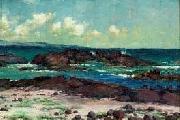 |
Helen Thomas Dranga
|
|
Helen Thomas Dranga (1866-1940), who is also known as Carrie Helen Dranga, was a painter who was born Carrie Helen Tufts in Oxford, England. She lived in Oakland, California from 1894 until 1900, when she moved to Hilo, Hawaii. Her paintings regularly appeared on the cover of Paradise of the Pacific magazine in the 1920s and 1930s. She lived in Hilo until shortly before her death in 1940.
The Honolulu Academy of Arts and the Lyman House Memorial Museum (Hilo, Hawaii) are among the public collections holding works by Helen Thomas Dranga
|
|
|
|
|
|
|
|
|
|
|
| Wholesale China Oil Painting Wholesale Oil Painting China Xiamen Portrait Reproduction on canvas Chinese Oil Painting Wholesale USA Oil Painting |
|
|
|
|
|